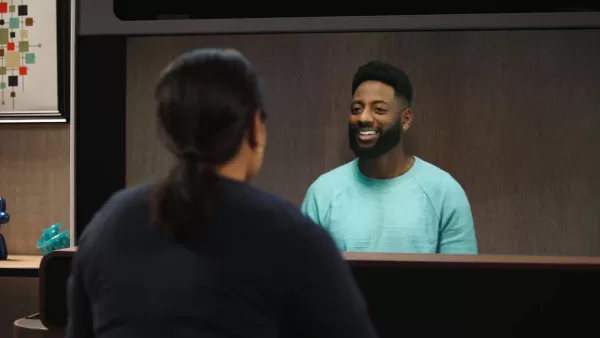Google is bringing Project Starline's 'magic window' to workplace video calls

Google's Project Starline: Revolutionizing Video Conferencing
Since its introduction in 2021, Google's Project Starline has been making waves as a futuristic alternative to traditional webcam video conferencing. Imagine chatting with a colleague from halfway around the world, yet feeling as if they're right there in the room with you. That's the essence of Project Starline, which uses a "magic window" powered by AI and 3D imaging to create a lifelike interaction where you can talk, gesture, and even make eye contact as if you were together in person.
Exciting news broke recently—Google has teamed up with HP to bring Project Starline to the market in 2025. This partnership aims to integrate the technology with popular video conferencing platforms like Google Meet and Zoom, making it more accessible to businesses and individuals alike.
Why Project Starline Matters
According to HP Personal Systems President Alex Cho, "With more than half of meaning and intent communicated through body language versus words alone, an immersive collaboration experience plays an important role in creating authentic human connections in hybrid environments." The collaboration with Google is a step toward revolutionizing how we connect in the workplace, leveraging AI to enhance the way we work together.
Google has been rigorously testing Project Starline within its own offices and with enterprise partners. The feedback? Remarkable. Users feel that meetings conducted via Project Starline are far more natural than standard video calls. They report a sense of presence, as if their colleagues were sitting right across the table. Not only that, but Google also notes that this technology enhances attentiveness and memory recall, mimicking the advantages of face-to-face interactions.
Andrew Nartker, Google's Project Starline general manager, expressed enthusiasm about the project's future: "Project Starline brings us closer to a world where distance is no longer a barrier to connection. We're thrilled to partner with HP to bring this technology to future products together."
How It Works
Project Starline employs an array of high-resolution cameras and custom-built sensors to capture a user's appearance and movements in 3D. These images are then processed in real time by AI algorithms, which render a live video that captures the subtleties of facial expressions and gestures. The result is displayed on a specialized screen designed to provide true depth perception, allowing participants to view the 3D images without the need for VR headsets or any additional equipment.
While this technology is perfect for conference rooms and offices, its specialized display requirement means it's less suited for home use. However, the potential for creating a more connected work environment is undeniable, especially as remote and traveling workers increasingly rely on digital platforms like Zoom and Slack huddles to stay in touch and collaborate.
Looking Forward
As we look to the future, Project Starline isn't the only player in the game of enhancing remote presence. Apple's Vision Pro, for instance, offers a similar sense of presence with its Persona feature, though it operates within a virtual reality setting. While some users praise Persona for its utility, others find it unsettling, likening it to the uncanny valley effect.
As Google moves forward with commercializing Project Starline in 2025, it will be fascinating to see how users respond. Will they embrace the opportunity to experience a Starline Zoom call, or will they stick to traditional methods? Only time will tell, but one thing is clear: the future of video conferencing is looking more immersive and connected than ever.
Related article
 Seeking Faith and Purpose in an Age of Skepticism
In our modern age of scientific inquiry and critical thinking, maintaining spiritual faith often feels like walking against the tide. Many struggle to reconcile timeless beliefs with contemporary skepticism, leaving them longing for deeper meaning. T
Seeking Faith and Purpose in an Age of Skepticism
In our modern age of scientific inquiry and critical thinking, maintaining spiritual faith often feels like walking against the tide. Many struggle to reconcile timeless beliefs with contemporary skepticism, leaving them longing for deeper meaning. T
 How ChatGPT Works: Capabilities, Applications, and Future Implications
The rapid evolution of artificial intelligence is transforming digital interactions and communication. Leading this transformation is ChatGPT, an advanced conversational AI that sets new standards for natural language processing. This in-depth examin
How ChatGPT Works: Capabilities, Applications, and Future Implications
The rapid evolution of artificial intelligence is transforming digital interactions and communication. Leading this transformation is ChatGPT, an advanced conversational AI that sets new standards for natural language processing. This in-depth examin
 Salesforce’s Transformer Model Guide: AI Text Summarization Explained
In an era where information overload is the norm, AI-powered text summarization has become an indispensable tool for extracting key insights from lengthy documents. This comprehensive guide examines Salesforce's groundbreaking AI summarization techno
Comments (3)
0/200
Salesforce’s Transformer Model Guide: AI Text Summarization Explained
In an era where information overload is the norm, AI-powered text summarization has become an indispensable tool for extracting key insights from lengthy documents. This comprehensive guide examines Salesforce's groundbreaking AI summarization techno
Comments (3)
0/200
![FredAllen]() FredAllen
FredAllen
 September 2, 2025 at 12:30:33 PM EDT
September 2, 2025 at 12:30:33 PM EDT
Esta tecnología de Google parece sacada de una película de ciencia ficción 🚀 ¿Pero cuánto costará implementarla en las oficinas? Me encantaría probarla, pero apuesto a que solo las grandes empresas podrán permitírselo al principio. #FuturoPresente


 0
0
![JackMitchell]() JackMitchell
JackMitchell
 August 6, 2025 at 7:00:59 AM EDT
August 6, 2025 at 7:00:59 AM EDT
This Project Starline sounds like sci-fi magic! 🪄 I can’t wait to see if it really feels like my coworker is in the room. But, is Google planning to make this affordable for small businesses or just big corporates? 🤔


 0
0
![GaryGarcia]() GaryGarcia
GaryGarcia
 August 4, 2025 at 11:00:59 PM EDT
August 4, 2025 at 11:00:59 PM EDT
This Starline thing sounds wild! Like video calls but you’re practically in the room. Can’t wait to see if it’s as cool as it sounds or just Google hyping things up again. 😎


 0
0

Google's Project Starline: Revolutionizing Video Conferencing
Since its introduction in 2021, Google's Project Starline has been making waves as a futuristic alternative to traditional webcam video conferencing. Imagine chatting with a colleague from halfway around the world, yet feeling as if they're right there in the room with you. That's the essence of Project Starline, which uses a "magic window" powered by AI and 3D imaging to create a lifelike interaction where you can talk, gesture, and even make eye contact as if you were together in person.
Exciting news broke recently—Google has teamed up with HP to bring Project Starline to the market in 2025. This partnership aims to integrate the technology with popular video conferencing platforms like Google Meet and Zoom, making it more accessible to businesses and individuals alike.
Why Project Starline Matters
According to HP Personal Systems President Alex Cho, "With more than half of meaning and intent communicated through body language versus words alone, an immersive collaboration experience plays an important role in creating authentic human connections in hybrid environments." The collaboration with Google is a step toward revolutionizing how we connect in the workplace, leveraging AI to enhance the way we work together.
Google has been rigorously testing Project Starline within its own offices and with enterprise partners. The feedback? Remarkable. Users feel that meetings conducted via Project Starline are far more natural than standard video calls. They report a sense of presence, as if their colleagues were sitting right across the table. Not only that, but Google also notes that this technology enhances attentiveness and memory recall, mimicking the advantages of face-to-face interactions.
Andrew Nartker, Google's Project Starline general manager, expressed enthusiasm about the project's future: "Project Starline brings us closer to a world where distance is no longer a barrier to connection. We're thrilled to partner with HP to bring this technology to future products together."
How It Works
Project Starline employs an array of high-resolution cameras and custom-built sensors to capture a user's appearance and movements in 3D. These images are then processed in real time by AI algorithms, which render a live video that captures the subtleties of facial expressions and gestures. The result is displayed on a specialized screen designed to provide true depth perception, allowing participants to view the 3D images without the need for VR headsets or any additional equipment.
While this technology is perfect for conference rooms and offices, its specialized display requirement means it's less suited for home use. However, the potential for creating a more connected work environment is undeniable, especially as remote and traveling workers increasingly rely on digital platforms like Zoom and Slack huddles to stay in touch and collaborate.
Looking Forward
As we look to the future, Project Starline isn't the only player in the game of enhancing remote presence. Apple's Vision Pro, for instance, offers a similar sense of presence with its Persona feature, though it operates within a virtual reality setting. While some users praise Persona for its utility, others find it unsettling, likening it to the uncanny valley effect.
As Google moves forward with commercializing Project Starline in 2025, it will be fascinating to see how users respond. Will they embrace the opportunity to experience a Starline Zoom call, or will they stick to traditional methods? Only time will tell, but one thing is clear: the future of video conferencing is looking more immersive and connected than ever.
 Seeking Faith and Purpose in an Age of Skepticism
In our modern age of scientific inquiry and critical thinking, maintaining spiritual faith often feels like walking against the tide. Many struggle to reconcile timeless beliefs with contemporary skepticism, leaving them longing for deeper meaning. T
Seeking Faith and Purpose in an Age of Skepticism
In our modern age of scientific inquiry and critical thinking, maintaining spiritual faith often feels like walking against the tide. Many struggle to reconcile timeless beliefs with contemporary skepticism, leaving them longing for deeper meaning. T
 How ChatGPT Works: Capabilities, Applications, and Future Implications
The rapid evolution of artificial intelligence is transforming digital interactions and communication. Leading this transformation is ChatGPT, an advanced conversational AI that sets new standards for natural language processing. This in-depth examin
How ChatGPT Works: Capabilities, Applications, and Future Implications
The rapid evolution of artificial intelligence is transforming digital interactions and communication. Leading this transformation is ChatGPT, an advanced conversational AI that sets new standards for natural language processing. This in-depth examin
 Salesforce’s Transformer Model Guide: AI Text Summarization Explained
In an era where information overload is the norm, AI-powered text summarization has become an indispensable tool for extracting key insights from lengthy documents. This comprehensive guide examines Salesforce's groundbreaking AI summarization techno
Salesforce’s Transformer Model Guide: AI Text Summarization Explained
In an era where information overload is the norm, AI-powered text summarization has become an indispensable tool for extracting key insights from lengthy documents. This comprehensive guide examines Salesforce's groundbreaking AI summarization techno
 September 2, 2025 at 12:30:33 PM EDT
September 2, 2025 at 12:30:33 PM EDT
Esta tecnología de Google parece sacada de una película de ciencia ficción 🚀 ¿Pero cuánto costará implementarla en las oficinas? Me encantaría probarla, pero apuesto a que solo las grandes empresas podrán permitírselo al principio. #FuturoPresente


 0
0
 August 6, 2025 at 7:00:59 AM EDT
August 6, 2025 at 7:00:59 AM EDT
This Project Starline sounds like sci-fi magic! 🪄 I can’t wait to see if it really feels like my coworker is in the room. But, is Google planning to make this affordable for small businesses or just big corporates? 🤔


 0
0
 August 4, 2025 at 11:00:59 PM EDT
August 4, 2025 at 11:00:59 PM EDT
This Starline thing sounds wild! Like video calls but you’re practically in the room. Can’t wait to see if it’s as cool as it sounds or just Google hyping things up again. 😎


 0
0





























